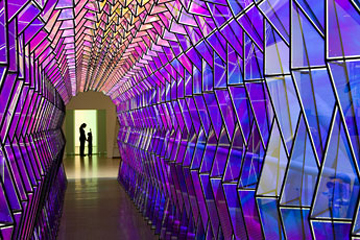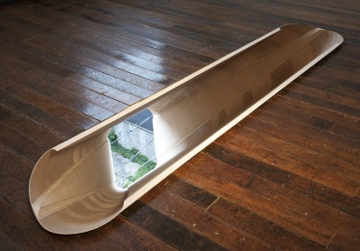
Lygia Clark, "Diálogo: Óculos (Dialogue: Goggles)," 1968. Modified diving goggles, metal, and mirror. Clark Family Collection, Rio de Janeiro. Photo: Eduardo Clark. © 2008 "The World of Lygia Clark" Cultural Association.
We each look at the world from our own individual perspectives, within contexts that are constantly shifting. Our unique outlook as viewers, the specific viewpoint of the artist, the curatorial decisions of the institution — all influence the following question: How do we experience art? Today, we launch the new Flash Points topic, Art and Experience, which will explore this question from different vantage points.
In John Dewey‘s book on aesthetic perception, Art as Experience, he discusses how art can become removed from our everyday reality:
The very perfection of some of these products, the prestige they possess because of a long history of unquestioned admiration, creates conventions that get in the way of fresh insight. When an art product once attains classic status, it somehow becomes isolated from the human conditions under which it was brought into being and from the human consequences it engenders in actual life-experience.
Throughout this topic, we’ll look at artists who seek to bring art back into the realm of human experience and remove the walls between viewer and creator — from those who immerse the visitor in a new environment, to artists who encourage direct interaction with the work of art. As Allan Kaprow has famously stated, “The line between art and life should be kept as fluid, and perhaps indistinct, as possible.”

Olafur Eliasson, "One-way colour tunnel," 2007. Site-specific sculpture. Courtesy the artist; Tanya Bonakdar Gallery, New York; and neugerriemschneider, Berlin. © 2007 Olafur Eliasson.
We’ll look at the different ways we digest information, or as Howard Gardner explained in his theory of multiple intelligences, the different ways we interact with the world, and how this factors into the curriculum of art education programs. Joseph Beuys mentioned the issues inherent in this process while discussing his performance, How to Explain Pictures to a Dead Hare (1965): “…everyone consciously or unconsciously recognizes the problem of explaining things, particularly where art and creative work are concerned, or anything that involves a certain mystery or question.”
Institutional decisions also strongly impact the experience of art. The decision made by a curator to juxtapose two works of art is meant to elicit a certain reaction from the viewer, or encourage a specific connection to be made. Even the type of label (or lack thereof) provides a pre-determined amount of pedagogical information — all geared towards a calculated visitor experience. Some institutions, such as the Mattress Factory in Pittburgh, PA, has made it its mission to work with artists who transform its galleries into immersive environments that fully engage our senses.

Sarah Oppenheimer, "610-3356," 2008. Aircraft grade plywood, framing structure, view into neighboring yard across street. The Mattress Factory.
Here are a few of the questions we’ll be addressing over the coming months. We’d love to hear your thoughts, and any ideas you have for additional sub-topics, in the comments below:
- How do we experience art?
- How do our backgrounds influence the art viewing experience?
- Do art education programs accommodate different modes of learning?
- How are contemporary artists utilizing multi-sensory experiences?
- How do institutions approach the idea of visitor experience?
- Does contemporary art push our boundaries of perception?



